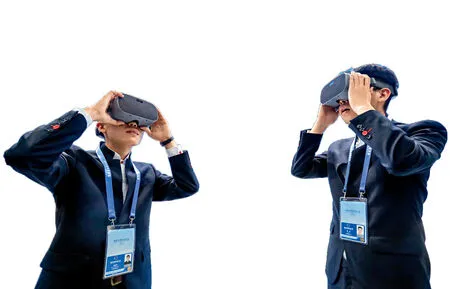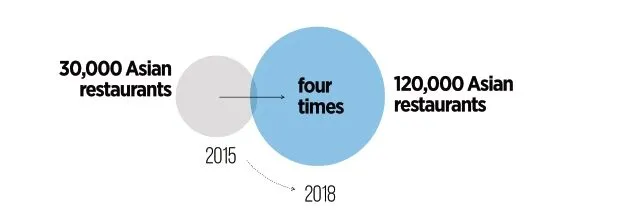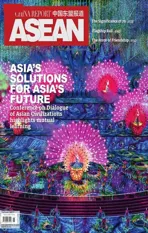CONNECTING THE PRESENT AND FUTURE
2019-07-30ByWangFengjuan
By Wang Fengjuan

Visitors experience immersive AR technology at the Media Center of the Conference on Dialogue of Asian Civilizations on May 14.
Conference on Dialogue of Asian Civilizations provides a platform for exhibiting cuttingedge technologyO n May 15, the Conference on Dialogue of Asian Civilizations(CDAC) opened in Beijing.Chinese President Xi Jinping delivered a keynote speech at the opening ceremony.
“To meet our common challenges and create a better future for all, we look to culture and civilization to play their role, which is as important as the role played by the economy, science and technology,” said Xi. “The CDAC is convened precisely for this purpose—it creates a new platform for civilizations in Asia and beyond to engage in dialogue and exchanges on equal footing to facilitate mutual learning.”
The CDAC created a new platform for exhibiting state-of-the-art technology.With the development of science and technology, digital products,Internet of Things (IoT) and artificial intelligence (AI) have become parts of daily life. Science and technology have led the trend of the times, breaking through the boundaries of the past and connecting the present with the future.
Robot Receptionist and AR Museum
“Amy, where is the News Conference Hall?” “Amy, which way is the restaurant?” Amy, a robot receptionist at the Media Center of the CDAC, has answers for all kinds of questions.
Amy is equipped with real-time mapping and positioning technology,high-precision facial recognition and big data analysis, which enables her to provide visitors with plentiful information.
The Immersive AR (Augmented Reality) Interactive Area in the AR Museum attracted considerable attention from journalists. With equipment known as an “Electronic Magnifier,” people could see what a damaged cultural relic would look like after restoration. With VR goggles at the Virtual Reality (VR) Interactive Area, visitors could see 10 sets of live 3D pictures of major scenic spots in Beijing and other parts of China.
At the Walk-in Photo Interactive Area, visitors could stand in front of a green curtain, choose the Great Wall or other famous Asian scenic spots as the background, and take a picture as if they were there. They could receive a print or save the electronic version to a phone to share with friends.
Two interactive islands were also found in the Multi-Media Interactive Area, each consisting of three 55-inch LCD screens. Users could select an interest from the choices “China’s World Heritage,” “Silk Road” or“Maritime Silk Road” to view content or piece together jigsaw puzzles.
The Media Center was equippedwith facial recognition lockers. To lock or unlock a locker, the user simply smiled for the camera.

Visitors attracted by an intelligent food delivery robot at the Asian Cuisine Festival,part of the Conference on Dialogue of Asian Civilizations, on May 16.

A visitor experiences “facial recognition self-service cashier”at the Asian Cuisine Festival, part of the Conference on Dialogue of Asian Civilizations, on May 16.

Two visitors play a shadow board game atthe Asian Cuisine Festival, part of the Conference on Dialogue of Asian Civilizations.
With the impressive combination of facial recognition lockers, robotic receptionist and 5G WiFi internet access, the Media Center became an exhibition hall of high-end technology.
Art Embraces Digital Technology
The Asian Digital Art Exhibition,held from May 18 to June 15, includes works of 30 artists from 12 countries and regions. On theme of Asian civilizations, artists combined art and digital technology to cut to the soul of Asian civilizations.
The first work in the exhibition is The Character of Chinese Characters, a hand-drawn animated film by Chinese artist Xu Bing. The origin and evolution of Chinese characters were displayed in motion pictures on a 20-meter-wide screen. Scenes of daily life gradually melt into abstract lines and eventually rejoin into square Chinese characters.It is quite a thought-provoking work.According to Xu, he was inspired by the calligraphic works of Zhao Mengfu(1254-1322, Yuan Dynasty calligrapher and painter). The film expounds on the character of the Chinese nation considering that the scripts of Chinese characters have affected the character of the nation.
Also on display at the exhibition are Chinese Calligraphy in Motion, Peking Opera Virtual Actors and Chinese Kung Fu in Motion by German artist Tobias Gremmler, Kung Fu Visualization by Australian artists Jeffrey Shaw and Sarah Kenderdine and Beyond the Frame by Taiwanese artist Lin Junting.Elements of Asian civilizations are deftly displayed in these works.Cultural symbols of China such as calligraphy, Peking Opera and kung fu are all displayed in a digital, audiovisual way. The theme of the CDAC is“exchanges and mutual learning among Asian civilizations and a community with a shared future.” Against this backdrop, the exhibition showcases the influence of Chinese civilization on Asia and the world at large.
New media artists have created new styles of art that have subverted styles of traditional art in many minds. When art embraces digital technology, a new platform of cultural innovation will be created for the future.
Numerous successful digital art works from recent years were invited to the exhibition including Dream of Database by Turkish artist Refik Anadol,Memorial Project Vietnam by Vietnamese artist Jun Nguyen-Hatsushiba, Unfold by Japanese artist Ryoichi Kurokawa and Chalkroom jointly created by Taiwanese artist Hsin-Chien Huang and American artist Laurie Anderson. Some of the latest digital art collaborations between young Chinese artists and famous digital businesses are also on display.

By the end of 2018, Meituan-Dianping had catalogued more than 120,000 Asian restaurants in China’s mainland, nearly four times more than in 2015.

The total number of Chinese restaurants in Asian countries surpassed 44,000 in 2018, an increase of about 120 percent on 2015.

Form of Time: Peking Opera at the Asian Digital Art Exhibition in Beijing.
Food Culture and Technology
As part of the CDAC, the Asian Cuisine Festival featured a fusion of food culture and technology at the six best-known shopping malls in Beijing. To demonstrate the development of intelligent catering technology, Meituan-Dianping (a Chinese website for food delivery,consumer products and retail services) showed 3D films presenting virtual Asian cuisine on a virtual banquet table. It sucks viewers into the whole cooking process so they could deeply appreciate Asian culinary culture and its inheritance.
To explore the most popular Asian cuisine, visitors could use the“Asian Food Thermometer” powered by Meituan-Dianping to search for “Popular Food” across 47 Asian countries, including the most popular specialty foods, restaurants and hotspots.
Xiao Dai, Meituan-Dianping’s autonomous food delivery robot, can accurately locate its next destination and plan the best route. Sensors in the delivery box manage real-time control of food temperature. Fu Dai, another food delivery robot, was specially designed by Meituan-Dianping to meet the needs of indoor food delivery in office buildings.
Meituan-Dianping’s application of the latest technologies such as unmanned delivery, self-service cashiers and intelligent settlement in the catering industry is helping businesses realize supply-side digitization involving the size of their restaurants, the amount of food sold,delivery capacity, upstream supply chain and other areas. The many efforts on the supply side coupled with digitization on the demand side will accelerate the overall digitization of Chinese catering industry.
During the festival, harnessing big data amassed from 400 million annual transaction users, Meituan-Dianping released Asian Cuisine in Numbers, a big-data report consisting of three parts: Asian Food in China, Chinese Food in Asia and Food Consumption of Chinese Tourists in Asia. Statistics show that the number of Asian restaurants in China’s mainland has continued to grow, with a year-onyear growth of more than 50 percent.By the end of 2018, Meituan-Dianping had catalogued more than 120,000 Asian restaurants in China’s mainland,nearly four times more than in 2015.Japanese, Korean and Southeast Asian restaurants are the most numerous restaurants serving foreign cuisine.The total number of South Asian, West Asian and Central Asian restaurants is not as large, but their growth rate is high. Asian cuisine is colorful and diverse and becoming more and more popular with Chinese people.
The total number of Chinese restaurants in Asian countries surpassed 44,000 in 2018, an increase of about 120 percent on 2015. In terms of distribution, Chinese restaurants can be found in all parts of Asia, mostly in East Asia and Southeast Asia.
For Chinese tourists traveling in Asian countries, food consumption has become an important part of the itinerary. The number of Chinese visitors consuming Asian cuisine at Meituan-Dianping increased by 33 percent in 2018 compared to the same period of the previous year.Sushi, sukiyaki, sea urchin rice,ginseng chicken soup, army hot pot,curry crab, mango glutinous rice and bak kut teh are all very popular with Chinese tourists.
